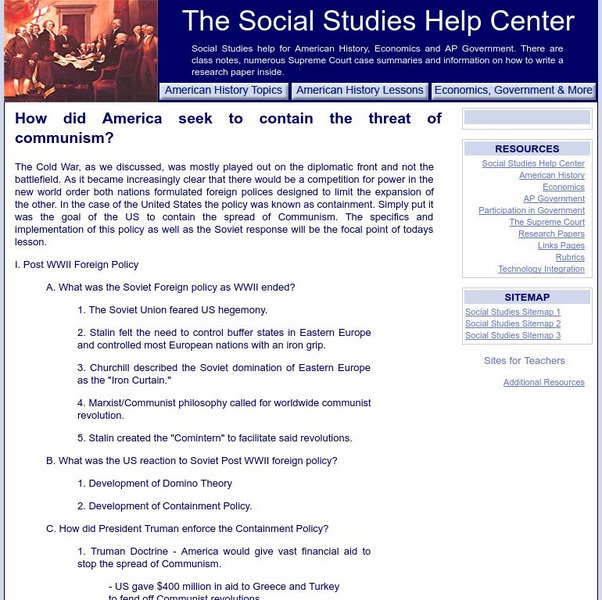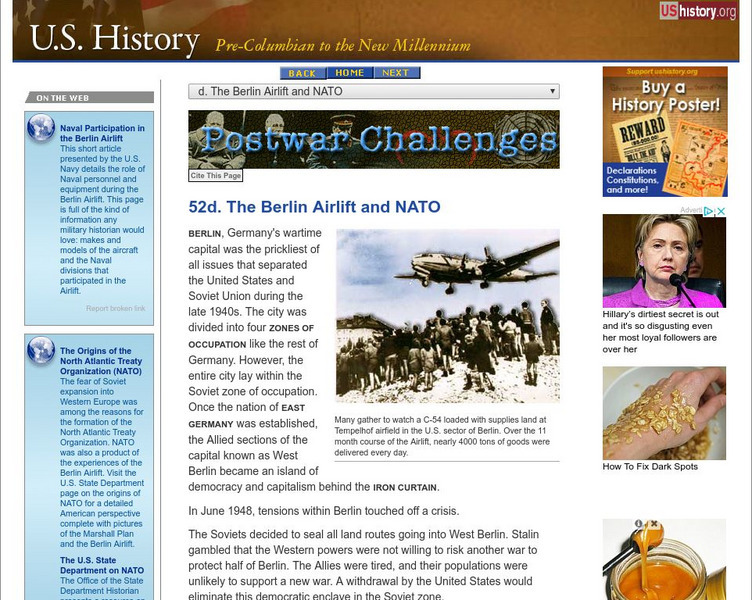Curated OER
Eisenhower's Foreign Policy
Good for setting the context for 20th century foreign policy issues, these slides describe key points in Latin America, the Middle East, the Far East, and Europe. US or World History classes will appreciate the concise list on each...
Curated OER
Exploring US Foreign Policy after WWII--The Cold War
Scholars explore U.S. Foreign Policy and Cold War ideologies adopted after WWII. They conduct Internet research on a topic or issue related to the Cold War Era, watch two films, and compose a time line and a multimedia presentation to...
Curated OER
Foreign Policy: Containment
Students examine opinions regarding the American policy of containment. In this Cold War lesson, students read articles by George F. Kennan and Walter Lippmann. Students compare the perspectives of the 2 men on U.S. foreign policy.
Curated OER
Cold War
Eleventh graders analyze U.S. foreign policy since World War II, tracing origins and geopolitical consequences (foreign and domestic) of the Cold War and containment policy.
Harry S. Truman Library & Museum
Harry S. Truman And Korea
Engage the class in researching oral histories and historical revision, in order to gain a greater understanding and appreciation for the sacrifices made by Americans in the Korean War. The inquiry process is scheduled to take one week....
Curated OER
Truman & the Beginning of the Cold War (5)
In this online interactive American history instructional activity, students respond to 13 matching questions regarding the Truman presidency and the Cold War. Students may check their answers immediately.
North Carolina School of Science and Mathematics
Henry Kissinger and Detente
How did relations between the United States and the People's Republic of China evolve between 1950 and 1970? Your young historians will complete a timeline of events with evidence that the relationship between these two great...
Curated OER
The Bush Doctrine
Learners analyze the Bush Doctrine and its effects on foreign policy. In this foreign policy lesson, students read and discuss the Bush Doctrine. Learners research and debate on whether or not the Bush Doctrine should be part of U.S....
Curated OER
The Role Of NATO
Students examine the role of the North Atlantic Treaty Organization (NATO). In this NATO lesson, students research the Truman Doctrine, the Marshall Plan, Winston Churchill's "Iron Curtain" speech, and the Berlin airlift and how they...
University of California
Anti-Communism at Home
Have you ever been accused of something without cause? The sixth installment of an eight-part series asks scholars to create a museum exhibit on the anti-communist activities in the United States at the start of the Cold War. To make...
Curated OER
In Cold Blood
In this online interactive reading comprehension worksheet, students respond to 25 multiple choice questions about Capote's In Cold Blood. Students may submit their answers to be scored.
Curated OER
The Cold War Era (1945 - 1991)
Provide learners with an excellent resource focused on the Cold War Era. Starting in 1945 and going all the way to 1991, the Cold War Era included major historical events, such as the Berlin Wall, Warsaw Pact, the Korean War, and the...
Foreign Policy Research Institute
Categories of Cold War Histiography
While the objective is to provide an overview of the Cold War in preparation for further study, this resource addresses the topic at a rather advanced level, and might need its own introductory lesson. The handouts include terms such as...
Foreign Policy Research Institute
Understanding the Koreas
Though this resource was designed in 2005, US tension with North Korea remains a relevant topic for exploration and understanding. Unfortunately, this lecture and reading-based lesson is unlikely to engage the class. The end product is a...
Curated OER
Cold War
In this online interactive world history worksheet, learners answer 21 matching questions regarding the Cold War. Students may submit their answers to be scored.
Digital History
Digital History: Postwar America: 1945 1960, the Containment Policy
Digital History discusses the Containment Policy of the 1950s. Includes information on the Marshall Plan, the fate of Germany, the Berlin blockade, and NATO.
Independence Hall Association
U.s. History: Containment and the Marshall Plan
Read about President Truman's two-pronged foreign policy for Europe. Find out about his containment policy and the Truman Doctrine, which was manifested in the Marshall Plan.
Harry S. Truman Library and Museum
Truman Library: Telegram, George Kennan to George Marshall [Pdf]
See the "long telegram" sent by George Kennan to Secretary of State George Marshall in which he expressed his unflattering view of the USSR.
Siteseen
Siteseen: American Historama: Containment
The purpose of the United States policy of Containment was to restrict the spread of communism abroad and was strongly associated with the Domino Theory.
Siteseen
Siteseen: American Historama: Truman Doctrine
Discussion of the Truman Doctrine that pledged to support other countries in their struggle against communism, the key element being the policy of containment.
Social Studies Help Center
Social Studies Help Center: How America Contained the Threat of Communism
This site discusses America's post-World War II foreign policy in outline form.
Independence Hall Association
U.s. History: The Berlin Airlift and Nato
President Harry Truman was determined to contain the Soviet sphere of influence in Europe. See how the United States and Great Britain stood up to Stalin's attempt to take over West Berlin by blockading access to the city. Understand why...
Digital History
Digital History: Solutions to Five Crises [Pdf]
This site highlights the five foreign policy crises that needed the attention of Harry S. Truman at the end of World War II. Read about the US actions on these crises and determine how these actions affected foreign policy over the next...
Digital History
Digital History: Years of Decision [Pdf]
This site is from a unit that covers the period from the Second World War up to the Cold War. It looks at relations between the United States and the Soviet Union and the thinking of their leaders. Students are asked to consider five...



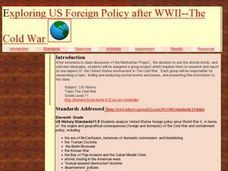



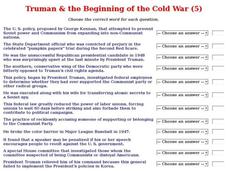









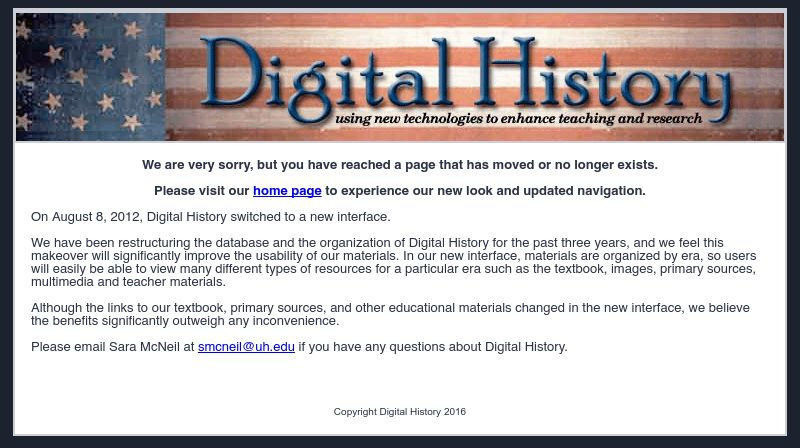
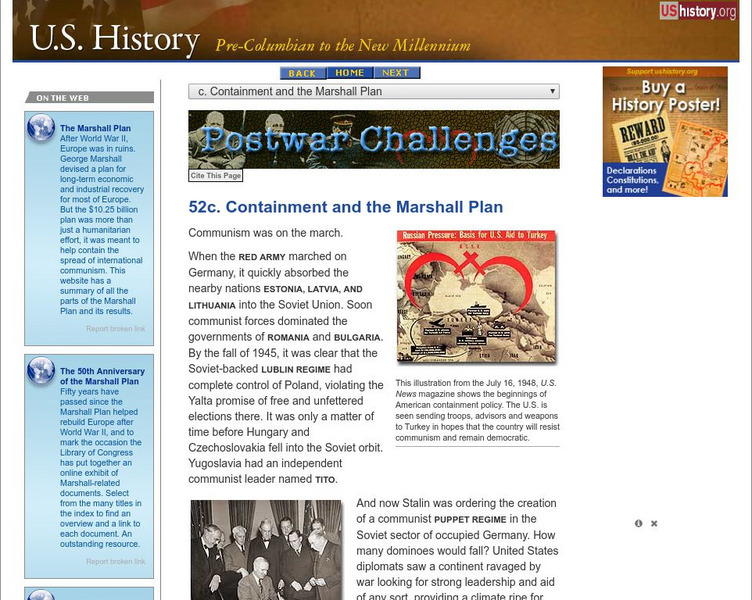
![Truman Library: Telegram, George Kennan to George Marshall [Pdf] Primary Truman Library: Telegram, George Kennan to George Marshall [Pdf] Primary](https://d15y2dacu3jp90.cloudfront.net/images/attachment_defaults/resource/large/FPO-knovation.png)


